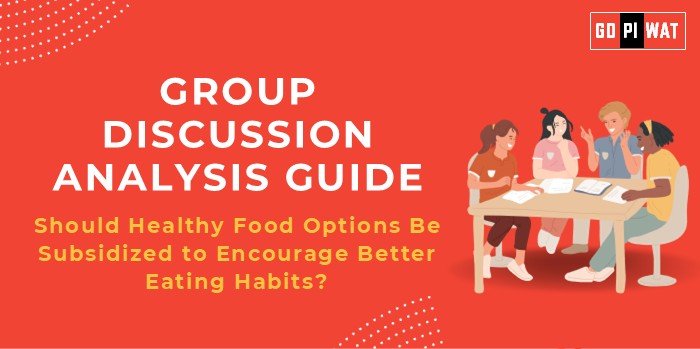📋 Group Discussion (GD) Analysis Guide: Should Healthy Food Options Be Subsidized to Encourage Better Eating Habits?
🌍 Introduction to the Topic
📖 Opening Context
Globally, lifestyle-related diseases such as obesity, diabetes, and heart conditions are increasing at an alarming rate. Subsidizing healthy food options has emerged as a potential solution to encourage healthier eating habits and curb this trend.
📜 Topic Background
The idea of subsidizing healthy food stems from the broader public health objective of reducing preventable diseases and promoting better nutrition. Countries like the UK and Denmark have experimented with taxes on unhealthy foods and subsidies for healthy alternatives. India’s growing burden of non-communicable diseases (NCDs) makes this discussion particularly relevant.
📊 Quick Facts and Key Statistics
- 🌍 Global Obesity Rates: Over 1 billion people worldwide are obese (WHO, 2023).
- 💰 Healthcare Costs: Lifestyle diseases contribute to over 70% of global healthcare expenses (World Bank, 2023).
- 🇮🇳 Indian Scenario: 1 in 4 adults in India is overweight; NCDs account for 60% of deaths annually (ICMR, 2023).
- 📈 Food Prices Impact: A 10% decrease in healthy food prices can increase consumption by 14% (Harvard Study, 2022).
🤝 Stakeholders and Their Roles
- 🏛️ Government: Policy formulation, subsidy allocation, and monitoring outcomes.
- 🏭 Food Industry: Reformulating products, ensuring affordable pricing, and transparency in marketing.
- 🏥 Healthcare Sector: Promoting awareness and measuring health impacts.
- 👥 Consumers: Adopting healthier eating habits and advocating for better choices.
🏆 Achievements and Challenges
✨ Achievements
- 📈 Positive Health Outcomes: Evidence from Finland shows reduced heart disease rates after implementing food subsidies.
- 🤝 Behavioral Shifts: Subsidies increase the consumption of fruits, vegetables, and whole grains.
- 💵 Economic Benefits: Reduced long-term healthcare costs associated with lifestyle diseases.
⚠️ Challenges
- 💰 Economic Feasibility: Subsidies require significant public funding, potentially affecting other welfare schemes.
- ⚖️ Market Distortion: Over-reliance on subsidies may discourage market-driven price adjustments.
🌎 Global Comparisons
- 🇫🇮 Success: Nordic countries have integrated subsidies with public health campaigns.
- 🇺🇸 Challenges: The US faces resistance from food lobbies opposing tax and subsidy initiatives.
📖 Case Study
The UK’s “Healthy Start Scheme” provides vouchers for low-income families to purchase fruits and vegetables, showing significant improvement in child nutrition levels.
💡 Structured Arguments for Discussion
- 👍 Supporting Stance: “Subsidizing healthy food can significantly reduce healthcare costs and improve public health outcomes.”
- 👎 Opposing Stance: “Food subsidies strain government resources and may not guarantee long-term behavioral change.”
- ⚖️ Balanced Perspective: “While subsidies promote healthy eating, they must be part of a holistic strategy including education and awareness.”
📈 Effective Discussion Approaches
🔑 Opening Approaches
- 📊 Statistical Start: “With lifestyle diseases accounting for 60% of deaths in India, subsidizing healthy food is a critical policy discussion.”
- 📖 Case-Based Approach: “The UK’s Healthy Start Scheme demonstrates the tangible benefits of subsidizing healthy food.”
🤔 Counter-Argument Handling
- ⚖️ Address economic concerns by suggesting public-private partnerships.
- 🌍 Highlight international successes to counter skepticism about efficacy.
🔍 Strategic Analysis of Strengths and Weaknesses
- 🌟 Strengths: Public health improvement, economic benefits through reduced healthcare spending.
- ⚠️ Weaknesses: Budget constraints, potential misuse of subsidies.
- 🚀 Opportunities: Integration with agricultural reforms, enhancing public-private collaborations.
- ⚡ Threats: Resistance from food lobbies, administrative challenges.
📚 Connecting with B-School Applications
- 🌐 Real-World Applications:
- 📋 Projects on public health economics, marketing strategies for healthy food brands, or supply chain optimizations for subsidized food programs.
- 💬 Sample Interview Questions:
- 🧠 “How would you design a subsidy model to promote healthy eating?”
- 📡 “What role can technology play in making healthy food more accessible?”
- 💡 Insights for B-School Students:
- 📊 Study consumer behavior trends in food choices.
- 📈 Explore the intersection of policy and business in addressing public health challenges.


